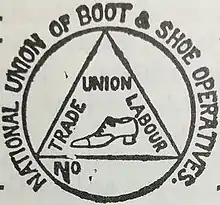National Union of Boot and Shoe Operatives
The National Union of Boot and Shoe Operatives (NUBSO) was a trade union in the United Kingdom which existed between 1873 and 1971. It represented workers in the footwear industry.
National Union of Boot and Shoe Operatives | |
 | |
| Merged into | National Union of Footwear, Leather and Allied Trades |
|---|---|
| Founded | 1873 |
| Dissolved | 1971 |
| Headquarters | The Grange, Earls Barton, Northamptonshire |
| Location | |
Members | 100,000 (1920)[1] |
| Affiliations | TUC, ITUC, Labour, ISLWF |
History
The union was founded in 1873, when many riveters and finishers left the Amalgamated Society of Boot and Shoe Makers. They were dissatisfied by their low status within the old union, and instead formed the National Union of Boot and Shoe Rivetters and Finishers (NUBSRF).[1] Membership in Leicester grew rapidly, with the next largest branches being Glasgow, London and Stafford. In total, by 1877, the union had about 4,000 members.[2]
A few women joined the union in the late 1880s, making it the first union outside the textile trades to admit both men and women. At this point, membership in the important shoe making centre of Northampton was low, with only about 600 of 15,000 shoe workers in the town holding union membership. That year, a five-week lock-out of members resulted in a settlement favourable to the union. This brought in hundreds of new members, and by the end of the year, its national membership reached 10,000.[2] The General Union of Clickers and Rough-stuff Cutters merged into the NUBSRF in 1892, but most of its members left again in 1895.[1]
During the late 1880s and early 1890s, socialists came to prominence in the union. They led campaigns against sweatshop working and outworking, where people worked from their own homes and were paid by item completed.[3] Under their influence, the union organised a 34-week strike in 1897, in support of a minimum wage and a 54-hour week, but this was unsuccessful.[1]
In 1897, the union renamed itself as the "National Union of Boot and Shoe Operatives", and joined the General Federation of Trade Unions the following year. Membership rose over 100,000 by 1920, although it soon fell to around 80,000.[1] Members in the Republic of Ireland left in 1953, to form the Irish Shoe and Leather Workers' Union.[4]
A major decline in the British shoe-making industry led the union to merge with the Amalgamated Society of Leather Workers, the National Union of Glovers and Leather Workers and the National Union of Leather Workers and Allied Trades in 1971, forming National Union of Footwear, Leather and Allied Trades.[1]
Election results
The union was affiliated to the Labour Party, and sponsored numerous Parliamentary candidates, many of whom won election.
Leadership
General Secretaries
- 1874: Thomas Smith
- 1878: George Sedgwick
- 1886: William Inskip
- 1899: W. Boyd Hornidge
- 1908: Edward L. Poulton
- 1930: George Chester
- 1949: Lionel Poole
- 1960: Richard Gregson
- 1968: T. A. Moore
General Presidents
- 1878: Edward Kell
- 1890: T. Horrabin
- 1892: Jabez Leedham
- 1892: John Judge
- 1893: W. Boyd Hornidge
- 1899: Charles Freak
- 1910: Thomas Frederick Richards
- 1930: W. R. Townley
- 1938: Len Smith
- 1944: James Crawford
- 1957: Sydney Robinson
References
- "National Union of Boot and Shoe Operatives", Trade Union Ancestors
- Fox, Alan (1958). A History of the National Union of Boot and Shoe Operatives: 1874-1957. Oxford: Basil Blackwell. pp. 75, 102–103.
- Fox, Alan (1958). A History of the National Union of Boot and Shoe Operatives: 1874-1957. Oxford: Basil Blackwell. pp. 105–117.
- John B. Smethurst and Peter Carter, Historical directory of trade unions, vol.6, p.101
- Frank Bealey and Henry Pelling, Labour and Politics, 1900-1906, pp.290-292
- Fox, Alan (1958). A History of the National Union of Boot and Shoe Operatives. Oxford: Basil Blackwell. p. 462.
- Labour Party, Report of the Twenty-second Annual Conference of the Labour Party, pp.255-272. Note that this list is of the sanctioned candidates as of June 1922, and there were some changes between this date and the general election.
- "List of Labour Candidates and Election Results, May 30th, 1929". Report of the Annual Conference of the Labour Party: 24–44. 1929.
- "List of Endorsed Labour Candidates and Election Results, October 27, 1931". Report of the Annual Conference of the Labour Party: 11–27. 1931.
- "List of Endorsed Labour Candidates and Election Results, November 14, 1935". Report of the Annual Conference of the Labour Party: 8–23. 1935.
- Labour Party, Report of the Forty-Fifth Annual Conference of the Labour Party, pp.232-248
- "List of Parliamentary Labour candidates and election results, February 23rd, 1950". Report of the Forty-Ninth Annual Conference of the Labour Party: 179–198. 1950.
- "List of Parliamentary Labour candidates and election results, 25th October, 1951". Report of the Fiftieth Annual Conference of the Labour Party: 184–203. 1951.
- Labour Party, Report of the Sixty-Fifth Annual Conference of the Labour Party, pp.308-330